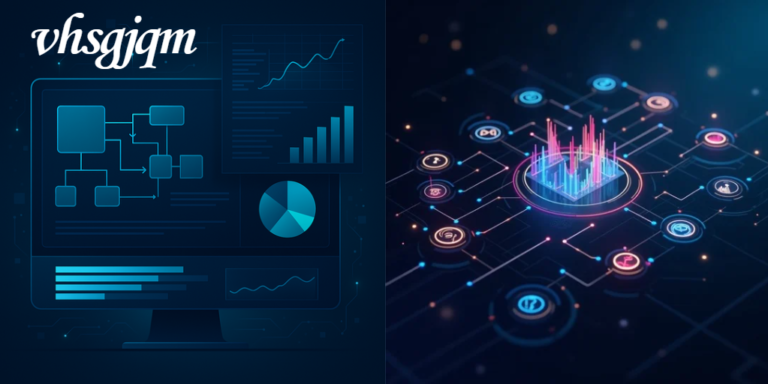Mastering qwioxiz2057: The Definitive Guide for Modern Enterprises
At its core, qwioxiz2057 is a modular framework designed for businesses that demand agility, security, and intelligence. Unlike single‑purpose tools, it blends predictive analytics, immutable ledgers, and orchestrated workflows to reduce manual toil and improve decision‑making.
This guide is written for CTOs, developers, and operations leaders who want a thorough yet accessible overview of the platform.
Core Architecture
Modular Design Overview
The heart of qwioxiz2057 is its modularity. Each layer—AI, blockchain, cloud, and automation—can be deployed independently or together. This approach lets organizations adopt only what they need today, then scale out additional modules as requirements evolve.
AI & Machine Learning Layer
Ingesting data from multiple sources, the AI layer uses built‑in preprocessing pipelines to cleanse and normalize inputs. A library of pre‑trained models supports tasks like demand forecasting, anomaly detection, and natural language understanding. Custom model training is simplified by a drag‑and‑drop interface or via the Python SDK.
Blockchain & Distributed Ledger Layer
Security and auditability come from the blockchain module. It employs a permissioned ledger with a pluggable consensus engine—organizations can choose between proof‑of‑authority for speed or Byzantine fault tolerance for resilience. Smart contracts are authored in a familiar language, then compiled into chaincode for deployment across nodes.
Cloud‑Native Infrastructure
Built to run on Kubernetes, qwioxiz2057 auto‑scales its microservices based on workload. Resource pools can be configured per module, ensuring that compute‑intensive AI tasks do not starve the automation engine. A built‑in cost‑optimizer rebalances workloads across regions to minimize cloud spend.
Automation & Orchestration Engine
The workflow designer offers a visual canvas where you connect triggers (like “new data arrival”) to actions (such as “run inference” or “create blockchain record”). For advanced scenarios, you can embed custom scripts in JavaScript or invoke external APIs, all with automatic retry logic and error notifications.
Getting Started
System Requirements & Prerequisites
Before installing qwioxiz2057, ensure you have a Kubernetes cluster (version 1.20+), a container registry, and at least 16 GB RAM across your nodes. You’ll also need administrative access to configure networking and storage classes.
Installation & Deployment Options
Deployment comes in two flavors: a one‑click Helm chart for evaluation, or a production setup using Terraform modules. The Helm chart bundles all components with sensible defaults, while Terraform gives fine‑grained control over networking, persistent volumes, and ingress.
Quickstart Tutorial: Your First Workflow
Once deployed, log into the admin console to create a workspace. Use the Quickstart wizard to define a simple workflow: ingest sample data, run a predictive model, and write results to the blockchain. Within minutes, you’ll see end‑to‑end orchestration in action.
AI‑Driven Capabilities
Data Ingestion & Preprocessing
Data connectors pull from sources such as S3, Kafka, and SQL databases. A visual pipeline editor allows you to apply transformations—filtering, enrichment, and normalization—without writing code. For power users, a Python notebook environment is embedded directly in the console.
Predictive Analytics & Model Training
The analytics dashboard presents model performance metrics—accuracy, precision, recall—in real time. You can schedule retraining jobs based on data drift thresholds, ensuring models stay current as conditions change.
Natural Language Processing Modules
Built‑in NLP pipelines handle tasks like sentiment analysis, entity recognition, and document summarization. A REST API endpoint makes it trivial to integrate these capabilities into existing applications.
Real‑Time Decisioning & Feedback Loops
When a model flags an anomaly, the automation engine can immediately trigger a remediation workflow—sending alerts, creating tickets, or invoking a rollback script. Feedback from each decision is logged to refine model accuracy over time.
Blockchain Integration
Consensus Mechanisms in qwioxiz2057
Choose between proof‑of‑authority for private networks or a federated BFT protocol when more nodes participate. Each option balances speed and fault tolerance according to your use case.
Smart Contracts & Chaincode Development
Developers write contracts in a high‑level language, then test them in a sandbox before deploying to production. A chaincode marketplace lets you share and reuse common business logic across teams.
Immutable Audit Trails & Compliance
Every transaction is time‑stamped and cryptographically signed, creating an unbroken audit trail. Regulators can be granted read‑only access to the ledger to verify compliance without exposing sensitive data.
Interoperability with Public Chains
When required, qwioxiz2057 can anchor private‑chain checkpoints to public networks (like Ethereum) for additional transparency and dispute resolution guarantees.
Cloud Scalability & Management
Auto‑Scaling Policies & Resource Pools
Define thresholds for CPU, memory, and custom metrics (e.g., queue length) to trigger scaling events. Resource pools ensure that critical services always have headroom, even during traffic spikes.
Multi‑Region Deployment Strategies
Replicate services across geographic regions to reduce latency and meet data residency requirements. A global load balancer directs users to the nearest endpoint, while state synchronization keeps all regions in lockstep.
Cost Optimization Techniques
A built‑in cost dashboard shows real‑time spend per module. Automated policies can shift non‑urgent batch workloads to lower‑cost spot instances or off‑peak hours.
Monitoring & Alerting Best Practices
Integration with Prometheus and Grafana provides rich dashboards for system health. Predefined alert rules notify you via Slack, email, or PagerDuty when any metric crosses a critical threshold.
Automation Engine
Workflow Designer Interface
The drag‑and‑drop designer supports branching, parallel tasks, and conditional logic. Connectors to common services (email, databases, messaging queues) are preconfigured.
Pre‑Built Automation Templates
Templates cover use cases such as nightly data syncs, compliance report generation, and incident response. These jump‑start your automation journey.
Custom Scripting & SDKs
When out‑of‑the‑box connectors don’t suffice, embed custom code in JavaScript or Python. SDKs handle authentication and retry logic, so your scripts focus on business logic.
Error‑Handling & Retry Logic
Every step in a workflow can be configured with retry counts, backoff strategies, and fallback actions, ensuring robust execution even in unstable environments.
Security & Compliance
End‑to‑End Encryption Standards
All data in transit and at rest is encrypted with AES‑256. Keys are managed via an integrated HSM or your existing KMS provider.
Identity & Access Management (IAM)
Fine‑grained roles and policies let you control who can view, modify, or deploy each component. Single sign‑on via SAML or OIDC integrates with enterprise directories.
Regulatory Compliance
Prebuilt templates help you generate reports for GDPR, HIPAA, and SOC2 audits. Data residency controls ensure sensitive data never leaves approved jurisdictions.
Penetration Testing & Vulnerability Scans
Automated security scans run against new releases. A dedicated vulnerability dashboard highlights critical issues and tracks remediation progress.
Developer Ecosystem
REST & gRPC APIs Overview
Comprehensive API docs describe endpoints for every service. gRPC support offers low‑latency communication for high‑throughput applications.
SDKs for Python, Java, JavaScript
Official SDKs wrap complex authentication flows and provide idiomatic interfaces for each language, reducing boilerplate.
CLI Tools & DevOps Integration
A command‑line client lets you script deployments, run tests, and manage workflows directly from your CI/CD pipelines.
Marketplace for Connectors & Plugins
Browse community‑contributed connectors for tools like Salesforce, ServiceNow, and more. Each plugin is vetted and versioned for compatibility.
Data Management & Storage
Supported Databases & File Stores
Choose from relational databases (PostgreSQL, MySQL), NoSQL stores (Cassandra, MongoDB), and object stores (S3, GCS). Storage classes can be tuned for performance or archival.
Data Lake vs. Data Warehouse Patterns
qwioxiz2057 supports both architectures: ingest raw data into a data lake for exploration, or load curated datasets into a warehouse for BI reporting.
Backup, Recovery & Archival Strategies
Automated snapshots and point‑in‑time recovery ensure data safety. Archival policies move cold data to low‑cost storage after configurable periods.
Data Governance & Lineage
A visual lineage graph shows how data flows between sources, transformations, and outputs. Policy enforcement ensures sensitive fields are masked or encrypted.
Real‑World Use Cases
Healthcare: Patient Data Automation
Hospitals use qwioxiz2057 to ingest medical device outputs, run diagnostic models, and immutably record treatment plans for compliance.
Finance: Fraud Detection & Audit
Banks deploy real‑time anomaly detection workflows that flag suspicious transactions and log every decision to the blockchain for post‑hoc review.
Manufacturing: Predictive Maintenance
Sensors stream equipment telemetry into the platform, where models predict failures. Automation then schedules maintenance before breakdowns occur.
Retail: Personalized Recommendations
E‑commerce sites analyze browsing and purchase history to generate on‑site and email recommendations, updating models hourly as new data arrives.
Public Sector: Transparent Procurement
Government agencies publish procurement bids on a public blockchain, ensuring transparent, tamper‑proof records accessible to citizens.
Performance Tuning
Benchmarking Tools & Metrics
A built‑in benchmarking suite measures throughput and latency under varying loads. Reports highlight which services need scaling or optimization.
Latency Optimization Techniques
Techniques such as connection pooling, caching, and query optimization reduce response times in critical paths.
Throughput Scaling
Horizontal scaling of microservices and message queues ensures that high‑volume workloads—like real‑time analytics—remain performant.
Resource Profiling & Bottleneck Analysis
Profiling tools pinpoint CPU, memory, or I/O bottlenecks. Recommendations guide you to reconfigure resource limits or refactor code.
Migration & Integration
Migrating from Legacy Systems
A migration toolkit helps extract data, transform it into the required schema, and validate consistency before cutover. Parallel run support lets you test new workflows without disrupting production.
Hybrid On‑Prem & Cloud Setups
qwioxiz2057 supports hybrid deployments, keeping sensitive data on‑premises while offloading compute‑heavy tasks to the cloud.
Integrating with ERP, CRM, BI Tools
Prebuilt connectors simplify integration with systems such as SAP, Salesforce, and Tableau. Custom integrations are supported via REST or gRPC.
Data Migration Best Practices
Phased migration, thorough testing, and rollback plans minimize risk. Detailed logs and audit trails ensure traceability.
Monitoring & Troubleshooting
Centralized Logging & Dashboards
All services feed logs into a centralized ELK stack. Preconfigured dashboards surface errors, latencies, and resource usage.
Distributed Tracing
Tracing spans track requests across microservices, revealing slow calls and misconfigurations.
Common Error Patterns & Resolutions
A knowledge base catalogues frequent issues—such as misconfigured ingress or database timeouts—and offers proven fixes.
Support Channels & SLAs
Enterprise customers receive 24/7 support via phone, email, and a dedicated Slack channel. SLA tiers guarantee response times.
Cost Management
Licensing Models & Pricing Tiers
Options range from open‑source community editions to enterprise subscriptions that include premium support, advanced modules, and white‑glove onboarding.
Cloud Spend Tracking
Real‑time dashboards show cost per module, region, and team. Alerts notify you when spend exceeds budget thresholds.
Rightsizing Resources
Automated recommendations suggest scaling down underutilized nodes or switching to more cost‑effective instance types.
ROI Calculation Framework
A built‑in calculator helps justify the investment by modeling labor savings, improved uptime, and reduced compliance costs.
Future Roadmap
Upcoming Features & Enhancements
Planned releases include low‑code workflow builders, expanded public‑chain bridges, and AI‑powered governance recommendations.
Community Contributions & Open Source
The core platform is open‑source, inviting community plugins and governance proposals through a public GitHub repository.
Emerging Trends in AI‑Blockchain Convergence
As on‑chain AI inference matures, qwioxiz2057 aims to support decentralized model marketplaces and verifiable compute.
How to Influence the Product Roadmap
Customers can vote on feature requests via the community portal and join early‑access programs for new modules.
FAQ’s
Can I deploy qwioxiz2057 on edge devices for low‑latency use cases?
Yes. A lightweight runtime can be installed on edge servers or IoT gateways, allowing local data processing and decision‑making. This minimizes round‑trip time to the central cloud cluster and supports offline operation with periodic synchronization.
What options exist for white‑labeling the qwioxiz2057 console?
Enterprises can customize the user interface with their own branding, including logos, color schemes, and custom domain names. This is configured via the theming API and a simple CSS override mechanism.
How can I get certified in qwioxiz2057 administration and development?
The vendor offers an official certification program comprising online courses, hands‑on labs, and a proctored exam. Certifications are available for administrators, data scientists, and DevOps engineers.
Is there a marketplace for third‑party modules compatible with qwioxiz2057?
A curated marketplace hosts connectors, chaincode templates, and AI model packages contributed by partners and the community. Modules are versioned and come with compatibility guarantees and security reviews.
What training resources are available for my team to ramp up quickly?
Beyond documentation, there are live webinars, on‑demand video tutorials, and guided workshops led by certified instructors. A sandbox environment with sample data is provided so teams can practice without impacting production.
Conclusion
This guide has unpacked qwioxiz2057 from its foundational architecture to advanced deployment patterns and real‑world applications. By understanding its modular design, AI and blockchain integration, and robust automation engine, you are now equipped to plan, deploy, and optimize qwioxiz2057 for your organization’s unique needs.
As you move forward, leverage the community, contribute your own extensions, and keep an eye on the evolving roadmap to stay ahead in the era of intelligent, secure, and scalable enterprise platforms.
Read more
Ultimate Guide to the artists directory arcyart – Discover, Connect, and Grow Your Art Career
The Ultimate Guide to know about wurduxalgoilds: Everything You Need to Know
In-Depth Guide on sdajfasdfa: Understanding, Applications, and Future Trends






